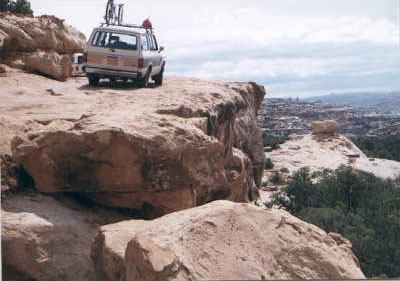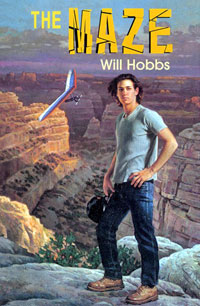 |
It was the condors. In December of 1996, my wife and I read that six young California condors had just been released at the Vermilion Cliffs, close to where we begin our Grand Canyon river trips. I was fascinated—I knew that the last wild condors had been captured and were part of a captive breeding program. The idea of seeing “nature's most magnificent flying machine” in the wild was so exciting, we drove right down there. It was a thrill to watch the huge young condors in flight. The biologists on site told us that they would be posting their field notes about the birds on their Web site. On my way home I was already thinking I should write a story in which a kid gets involved with the condors. I knew that my readers would be fascinated with this magnificent soaring bird. Imagine, a wingspan nearly ten feet across! Why did you choose the Maze in Canyonlands National Park for the setting of your story? A lot of my story ideas come from making associations as I'm daydreaming. I kept remembering the flying dreams I'd had when I was a kid. My main character could be a boy who has flying dreams. This brought to mind Icarus, from Greek mythology. Icarus flew out of an elaborate puzzle-prison called the labyrinth, on wings his father had fashioned for them both. The labyrinth reminded me of the Maze, about 150 miles up the Colorado River from Vermilion Cliffs. The Maze is the most remote part of Canyonlands, and would be a spectacular setting for a book. My main character could be a boy in a lot of trouble, who considers his whole life to be nothing but dead ends—a maze. When my publisher designed the cover for the paperback, they wrote, “When your life is a maze, you need wings.” Perfect.
Did you go hiking in the Maze yourself? We spent four days hiking in the Maze, for the fun of it and so I'd be able to write the descriptions. Its landscapes suggested all sorts of possibilities for the story. The four-wheel-drive “road” to get there (see photo) was fifty miles long. The last ten miles was so rough it took us five and a half hours! Did your idea of Rick flying the hang glider come from Icarus? Exactly. Icarus flew a prehistoric hang glider and Rick Walker would fly a modern one. The condor biologist Rick meets will be a hang glider pilot, which makes sense—he'd be a man who liked birds so much, he wanted to fly like one. Lon Peregrino would be in the position to teach Rick to fly. The hang gliding sounds so realistic. Did you fly one yourself? I wish! Maybe in another lifetime! I have a friend, though, who's been a hang glider pilot for over twenty years. I asked him if I could hang out with him and his buddies when they went flying. I got to watch them assemble their hang gliders and run off the cliffs. Driving his truck, I was in radio contact when he was at 15,000 feet. My friend talked me through what he was doing as he was flying the hang glider, how he finds and uses thermals and so on. After I'd written the story, I showed him all the parts that have hang gliding in them so he could check that they were correct. He spotted a place where I had Rick pulling on the control bar when he should have been pushing, so I fixed it. He also told me about a great video that has all kinds of hang gliding action, with lots of footage filmed from cameras right over the pilots' shoulders. Note: For more info on the writing of The Maze, see the Author's Note at the end of the book. |
|

